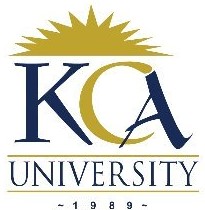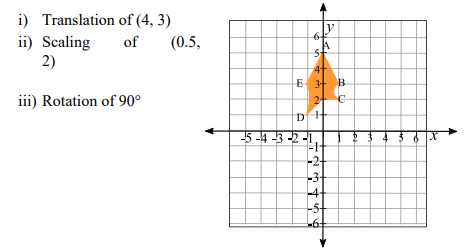 UNIVERSITY EXAMINATIONS: 2018/2019
UNIVERSITY EXAMINATIONS: 2018/2019
EXAMINATION FOR THE DEGREES OF BACHELOR OF SCIENCE IN
INFORMATION TECHNOLOGY/ APPLIED COMPUTING
BIT 2301 A/ BAC 3206: COMPUTER GRAPHICS
FULLTIME/ PART TIME/ DISTANCE LEARNING
ORDINARY EXAMINATIONS
DATE: AUGUST, 2019 TIME: 2 HOURS
INSTRUCTIONS: Answer Question One & ANY OTHER TWO questions.
QUESTION ONE [30 MARKS]
a) Distinguish between additive and subtractive color models. (4 Marks)
b) Real-world objects can be displayed on the screen in two ways. Explain. (4 Marks)
c) Explain the following graphics terms:
i) Ambient light
ii) Skewing
iii) Mesh (6 Marks)
d) Discuss any THREE key applications of computer-aided design (6 Marks)
e) Discuss SIX usability considerations when building a graphical user interface (6 Marks)
f) Explain and illustrate the FOUR conditions for drawing a point. (4 Marks)
QUESTION TWO [20 MARKS]
a) Explain the concept of transformation as it is used in computer graphics. (1 Mark)
b) Consider the following 2D object that has undergone a series of transformations:
Required:

Calculate the vertices of the transformed objects and plot these objects on a Cartesian plane.
Show your calculations. (9 Marks)
c) Distinguish between the X-shear and Y-shear and use appropriate diagrams to illustrate each
of these. (4 Marks)
d) Explain in detail the following approaches for hidden surface elimination:
i) Object precision (3 Marks)
ii) Image precision (3 Marks)
QUESTION THREE [20 MARKS]
a) Use the DDA algorithm to find intermediate points that can be drawn between the following
endpoints to generate a line. Show your calculations and the final list of points.
i) (5,7) and (16,13) (4 Marks)
ii) (4,5) and (8,14). (4 Marks)
b) Discuss situations where the DDA algorithm may be inefficient for drawing lines.
(3 Marks)
c) Define the following terms and use a diagram to illustrate each term
i) Global illumination
ii) Local illumination (6 Marks)
d) Discuss the Painter’s algorithm for drawing objects (3 Marks)
i) Translation of (4, 3)
ii) Scaling of (0.5,
2)
iii) Rotation of 90°
3
QUESTION FOUR [20 MARKS]
a) Explain the concept and relevance of clipping (2 Marks)
b) Identify any FOUR properties that a graphics model might contain (4 Marks)
c) Distinguish between the following terms:
i) Window and viewport
ii) Zooming and panning (4 Marks)
d) The Cohen-Sutherland line clipping algorithm divides the viewport into regions defined by
viewport edges and assign each region a 4-bit outcode. Draw a diagram to illustrate these
regions and explain how each of the outcodes is derived. (4 Marks)
e) Explain using an example how binary tests are used to decide whether to accept or reject the
end points of a line. (6 Marks)
QUESTION FIVE [20 MARKS]
a) Explain how flat shading is done, and identify THREE situations when it is appropriate to
use flat shading (5 Marks)
b) Discuss THREE advantages and THREE limitations of z-buffering (4 Marks)
c) Explain in detail how light affects the appearance of objects (5 Marks)
d) Describe the following basic sources of light:
i) Point light
ii) Spotlight
iii) Directional light (6 Marks)
